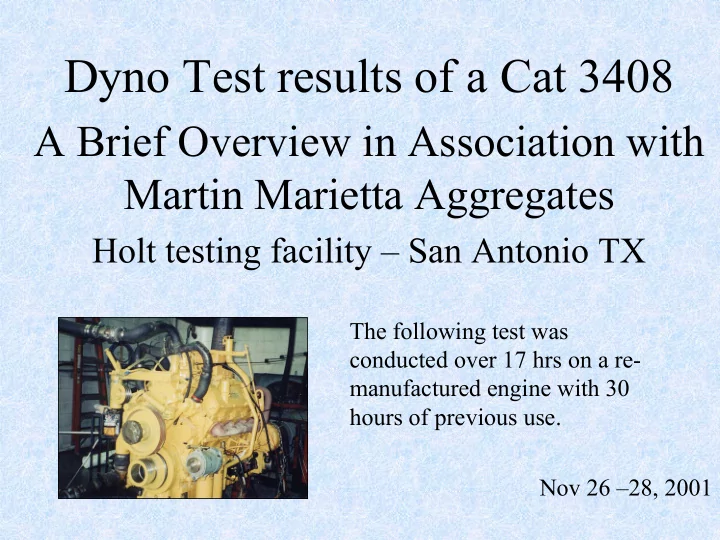

Dyno Test results of a Cat 3408 A Brief Overview in Association with Martin Marietta Aggregates Holt testing facility – San Antonio TX The following test was conducted over 17 hrs on a re- manufactured engine with 30 hours of previous use. Nov 26 –28, 2001
Inside the cylinder - before catalyst Power Stroke Exhaust Stroke Time = 13.6 milliseconds Time = 13.6 milliseconds Chained Hydrocarbons Exhaust Valve Opens Ignite and Burn Any Combustion After This Point Un-Chained Hydrocarbons Is Wasted Heat (Energy)! Smolder (Partial Combustion) After combustion, as the cylinder cools off, the un-used hydrocarbons smolder and energy is wasted in the exhaust.
Inside the cylinder - after catalyst Power Stroke Exhaust Stroke Time = 13.6 milliseconds Time = 13.6 milliseconds Exhaust Valve Opens Chained Hydrocarbons Ignite and Burn With less wasted energy, the exhaust temperature is lower. This test showed: 45º F less @ 50% Load Un-Chained Hydrocarbons Smolder (Partial Combustion) 119º F less @ 85% Load With the addition of the catalyst, the fuel can now use the oxygen more efficiently inside the engine, and is able to burn down to a lower temperature, this means the energy is used inside the engine rather than the exhaust.
Fuel Reduction If the engine is exhausting less heat, then it must be using the heat (work) on the power stroke, therefore requiring less fuel to perform the same job. This is verified during the Dyno test to show: 10.3% reduction @ 50% load 6.7% reduction @ 85% load
Increased Horsepower If the engine is using more of the heat (energy) produced from combustion for the power stroke, this must translate to an increase in available static torque or horsepower. This was shown by increasing the test engines maximum horsepower output from 447 Hp to 520 Hp, a 16.3% increase.
Cleaner Emissions If the fuel is burning more completely, then the emissions must be reduced. Opacity -79% (Static test – Load n/a) The black smoke is reduced Carbon Monoxide -40% (50% load) -60% (85% load) The conversion of CO is improved Hydrocarbons -33% (50% load) -66% (85% load) Less un-used hydrocarbons are present in the exhaust due to improved combustion Nox +16% (50% load) +29% (85% load) The Nox levels may increase during the initial ‘clean out’ period, while the soft and hard carbon deposits oxidize. 17 hours was not enough time for the Rhodium levels to build up. Note: These values do not even include additional reductions in overall pollutants resulting from the un-used fuel. If the fuel wasn’t used in the first place, it never had a chance to turn into pollution. This translates into even greater overall pollution reductions.
Smoother Running A spectral analyzer was used to measure the vibration produced during the operation of the engine. It is capable of deciphering and filtering out lower frequency vibration, such as the rotating mass in the bottom of the engine, as well as higher frequency vibration, such as the scraping of the rings against the cylinder liners. As changes in the engine occur (as in the addition of the catalyst), vibration analysis can be used to detect and quantify these changes. Because the combustion is smoother and more even, the overall vibration and torsional measurements from the engine should go down, while the ultrasonic energy (produced from combustion) should go up.
Torsion – Before Catalyst HOLT - 3408 Cat 3408 Cat -ET Engine Torsional Vibration 0.10 Route Spectrum 27-Nov-01 00:54:26 OVERALL= .1099 G-DG RMS = .1093 0.08 4.00 LOAD = 100.0 RPM = 2055. RMS Amplitude in +/- Deg RPS = 34.25 0.06 2.50 0.04 1.50 3.50 1.00 0.02 .50 3.00 5.00 2.00 5.50 4.50 0 0 1 2 3 4 5 6 7 8 Frequency in Orders Label: 85% Load - Without ET
Torsion – After Catalyst HOLT - 3408 Cat 3408 Cat -ET Engine Torsional Vibration 0.10 Route Spectrum 28-Nov-01 08:54:01 OVERALL= .1022 G-DG RMS = .1018 0.08 LOAD = 100.0 RPM = 2115. 4.00 RMS Amplitude in +/- Deg RPS = 35.26 0.06 2.50 0.04 1.00 1.50 3.50 0.02 5.00 3.00 .50 5.50 4.50 2.00 0 0 1 2 3 4 5 6 7 8 Frequency in Orders
Summary of Torsional Data Harmonics % Change Reductions in the torsion or the 0.50 -27% “dynamic torque” of an engine 1.50 -21% means that the engine is running smoother and that there is less 2.00 -23% strain on the rod bearings and main 2.50 -5% bearings, resulting in longer 3.00 -27% engine life. 3.50 -24% 4.00 -24% 4.50 -6% 5.00 -5% *The number 1.00 harmonic 5.50 7% revolution is removed due to excessive background interference
Ultrasonic Data – Before Catalyst HOLT - 3408 Cat 3408 Cat -SS1 SonicScan #1 Cylinder (43 kHz) 30 Route Waveform 27-Nov-01 00:55:17 RMS = 6.64 LOAD = 100.0 20 RPM = 2073. Amplitude in STANDARD RPS = 34.55 PK(+) = 21.42 PK(-) = 17.37 10 CRESTF= 3.23 0 Total = 38.79 -10 -20 0 0.5 1.0 1.5 2.0 Time in Seconds Label: 85% Load - without ET
Ultrasonic Data – After Catalyst HOLT - 3408 Cat 3408 Cat -SS1 SonicScan #1 Cylinder (43 kHz) 30 Route Waveform 27-Nov-01 17:20:10 RMS = 7.10 20 LOAD = 100.0 RPM = 2116. RPS = 35.26 Amplitude in STANDARD 10 PK(+) = 26.33 PK(-) = 19.28 CRESTF= 3.71 0 Total = 45.61 -10 Increase of 6.82 or 17.6% -20 -30 0 0.5 1.0 1.5 2.0 Time in Seconds
Summary of Ultrasonic Data Before Catalyst - 40.63 dB* After Catalyst - 43.93 dB* Net Change 3.3 dB or 8.13% This means that upon ignition the energy produced is 8.13% greater or longer, resulting from the more complete burn, this equates to more static torque or more horsepower. If the horsepower stays constant, less fuel will be needed to do the same work because the existing fuel will produce more. * - Averaged over cylinders 1,3,5,7
Recommend
More recommend